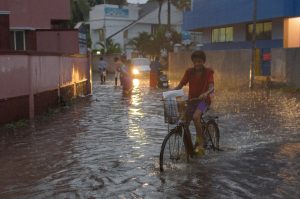65 South Asia
How do we define this region?
As we have with other regions, as geographers we seek to group similarities together in a region. What do we find that makes a coherent South Asia?
First, religion in South Asia is not Christianity. While it is true that Christianity, as a universalizing religion, can be found across the globe, in some regions this faith is found in very small numbers and similarly low percentages. In South Asia, Christians comprise about 2% of the population. Moreover, Christianity is no more than an insignificant percentage in each of the countries of South Asia. That is a key element of the region, otherwise only true in Central Asia and North Africa and the Middle East (NAME). In Southeast Asia and East Asia there are individual countries with sizeable Christian shares. However, in Central Asia and in NAME, Islam completely dominates the religious landscape. In South Asia, Islam is second to Hinduism, while other distinctive and regional faiths such as Buddhism and Sikhism (and even smaller shares of Jainism and Zoroastrianism) show similar levels of followers as Christianity. South Asia has the world’s highest percentages of Hinduism, Islam, Sikhism, Jainism, and Zoroastrianism. To summarize, South Asia is distinctive in its religious composition – negligible Christianity, but mixed with Hinduism first, Islam second, plus interesting domestic faiths.

Photo by Meena Kadri on Flickr.
Second, the languages of South Asia are mainly in the Indo-European family. If not, Indo-European, then other languages there are noteworthy only in South Asia. Hindi is the numerically dominant native language of India and thus of the region. The language tree from Indo-European languages branches between Indo-Iranian and European tongues. The Indo-Iranian branch forks into Iranian and the larger Indo-Aryan branch. Along the Indo-Aryan branches, Hindi is key in India, but several other common languages of South Asia are here too – Punjabi, Urdu, Bengali being most notable (less numerous – Sinhalese, Nepali, Kashmiri). The Iranian branch includes the South Asian languages of Pashtu and Baluchi. Southern India is an exception to this pattern, where Dravidian languages are commonly spoken. Due to previous British control of the region, English is the common lingua franca and happens to be in the Indo-European language family as well.

Photo by Roehan Rengadurai on Flickr.
Third, in terms of physical geography, South Asia is included in a transnational region called Monsoon Asia. This physical region includes Asian countries affected by tropical storms (often termed monsoons). South Asia includes most of the countries that are affected by the monsoons of the Indian Ocean. With the exceptions of Nepal and Bhutan, all of the countries of South Asia have coastline on the Indian Ocean. These coastal countries gain from plentiful rainfall, but also may suffer from flooding in the extremes of monsoon rains and storm surges. The mouth of the Brahmaputra River and the monsoon rains dominate the landscape and life of Bangladesh, including annual flooding. In addition to the coastal monsoons, mountains are key to the physical geography of South Asia. The Himalaya Mountains, the world’s highest, are featured in India, Pakistan, Nepal, and Bhutan. Exceptions to this rule are Bangladesh, mostly very flat as a river delta, and the Maldives, as a set of tiny islands barely above the level of the Indian Ocean).
Fourth, for historical geography, South Asia was part of the British Empire. The so-called British Raj was present from 1858 to 1947. The modern-day countries of Pakistan, India, and Bangladesh comprise the core of this colonial territory, but Burma (of Southeast Asia) also was a section for part of this time. Sri Lanka (then titled Ceylon) was a British Crown Colony but not part of British India. Similarly, the Maldives were a British protectorate, but included not in British India. Afghanistan battled against the British Empire, never quite been conquered. Nepal and Bhutan reached treaty agreements with the British Empire, guaranteeing their independence.
In sum,
- – The center of several world faiths, but not Christianity
- – Indo-European language family
- – Monsoon climate of the Indian Ocean
- – Mountains
- – British Empire (or at least a treaty or other agreement)
These rules work quite well for the region. Would any other country fit too? Perhaps Afghanistan, as it is contiguous to the region. It is a close call. Being landlocked, Afghanistan does not receive much of the monsoon’s effects. The British never quite colonized it. We contend that it fits slightly better in Central Asia; however, we recognize that it makes for a good geographical discussion.
Myanmar (Burma) could be considered for South Asia, having mountains and monsoons and a British historical link. However, religion is dominantly Buddhist and only a very few of its citizens natively speak an Indo-European language. Burmese is in the Sino-Tibetan group.
ACRONYM
BRIEFER
B – British
R – Raj
I – Indo-
E – European
F – Faithful (and not Christian)
E – Elevated (mountainous)
R – Rainfall (monsoons)
Did you know?
Cited and additional bibliography:
Kadri, Meena. Supreme. January 15, 2011. Photo. https://www.flickr.com/photos/meanestindian/6931594157/. Attribution-NonCommercial-NoDerivs 2.0 Generic (CC BY-NC-ND 2.0).
Rengadurai, Roehan. Monsoon. October 18, 2014. Photo. https://www.flickr.com/photos/iamroehan/18789371942/. Attribution-NonCommercial-NoDerivs 2.0 Generic (CC BY-NC-ND 2.0).


